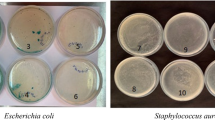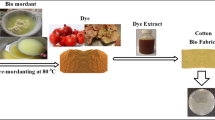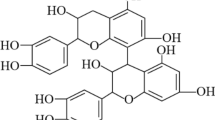Abstract
Novel results were obtained by selection of chitosan treatment parameters on cotton fabrics to obtain antimicrobial properties against E. coli, gram-negative bacteria. Taguchi experimental design was used in this study and microbial reduction rate was considered as the response. The signal-to-noise and the analysis of variance (ANOVA) were used to find the optimum levels to indicate the impact of treatment parameters on antimicrobial properties. The antimicrobial behavior of the fabric against bacterium as a function of each parameter was plotted. A verification test was also performed to prove the validity of Taguchi technique for this study after the determination of parameters’ optimum levels. Also the effect of chitosan and the mordanting on the dyeing properties of cotton fabrics with natural dyes such as walnut hull and safflower was investigated by measuring the color strength (K/S values) of the treated and untreated substrates at various concentrations. The results revealed that the K/S of dyed chitosan-treated cottons increased compared to untreated samples. In addition, antimicrobial properties of natural-dyed treated and untreated fabrics were determined. Walnut hull and safflower have shown antimicrobial properties. Although dyeing the chitosan-treated fabric reduced its antimicrobial effects but the results showed that chitosan-treated cotton fabrics had excellent antimicrobial properties against E. coli. Applying Taguchi experimental design for treating cotton fabrics with chitosan and utilizing these native natural dyes have never been used elsewhere.











Similar content being viewed by others
References
Dev VRG, Venugopal J, Sudha S, Deepika G, Ramakrishna S (2009) Dyeing and antimicrobial characteristics of chitosan treated wool fabrics with henna dye. Carbohydr Polym 75:646–650
Liu J, Liu C, Liu Y, Chen M, Hu Y, Yang Z (2013) Study on the grafting of chitosan gelatin microcapsules onto cotton fabrics and its antibacterial effect. Colloids Surf B Biointerf 109:103–108
Mahbubul Bashar M, Khan MA (2013) An overview on surface modification of cotton fiber for apparel use. J Polym Environ 21:181–190
Zamani A, Taherzadeh MJ (2012) Production of superabsorbents from fungal chitosan. Iran Polym J 21:845–853
El-tahlawy KF, El-bendary MA, Elhendawy AG, Hudson SM (2005) The antimicrobial activity of cotton fabrics treated with different crosslinking agents and chitosan. Carbohydr Polym 60:421–430
El-R Kenawy, Worley SD, Broughton R (2007) The chemistry and applications of antimicrobial polymers: a state-of-the-art review. Biomacromolecules 8:1359–1384
Vankar PS, Shanker R, Mahanta D, Tiwari SC (2008) Ecofriendly sonicator dyeing of cotton with Rubia cordifolia Linn. using biomordant. Dyes Pigments 76:207–212
Vankar PS, Shanker R, Verma A (2007) Enzymatic natural dyeing of cotton and silk fabrics without metal mordants. J Clean Prod 15:1441–1450
Ibrahim NA, El-Gamal AR, Gouda M, Mahrous F (2010) A new approach for natural dyeing and functional finishing of cotton cellulose. Carbohydr Polym 82:1205–1211
Cristea D, Vilarem G (2006) Improving light fastness of natural dyes on cotton yarn. Dyes Pigments 70:238–245
Oktem H, Erzurumlu T, Uzman I (2007) Application of Taguchi optimization technique in determining plastic injection molding process parameters for a thin-shell part. Mater Design 28:1271–1278
Sharma P, Verma A, Sidhu RK, Pandey OP (2006) Process parameter selection for strontium ferrite sintered magnets using Taguchi L9 orthogonal design. J Mater Proc Technol 168:147–151
Ebrahimi Jahromi A, Arefazar A, Moini Jazani O, Ganjaee Sari M, Saeb MR, Salehi M (2013) Taguchi-based analysis of polyamide 6/acrylonitrile-butadiene rubber/nanoclay nanocomposites: the role of processing variables. J Appl Polym Sci 130:820–828
Alonso D, Gimeno M, Olayo R, Vazquez-Torres H, Sepulveda-Sanchez JD, Shirai K (2009) Cross-linking chitosan into UV-irradiated cellulose fibers for the preparation of antimicrobial-finished textiles. Carbohydr Polym 77:536–543
Zhang Z, Chen L, Ji J, Huang Y, Chen D (2003) Antibacterial properties of cotton fabrics treated with chitosan. Text Res J 73:1103–1106
Leceta I, Guerrero P, Ibarburu I, Duenas MT, De la Caba K (2013) Characterization and antimicrobial analysis of chitosan-based films. J Food Eng 116:889–899
Singh R, Jain A, Panwar S, Gupta D, Khare SK (2005) Antimicrobial activity of some natural dyes. Dyes Pigments 66:99–102
Author information
Authors and Affiliations
Corresponding author
Rights and permissions
About this article
Cite this article
Mirshahi, F., Khosravi, A., Gharanjig, K. et al. Antimicrobial properties of treated cotton fabrics with non-toxic biopolymers and their dyeing with safflower and walnut hulls. Iran Polym J 22, 843–851 (2013). https://doi.org/10.1007/s13726-013-0183-x
Received:
Accepted:
Published:
Issue Date:
DOI: https://doi.org/10.1007/s13726-013-0183-x




